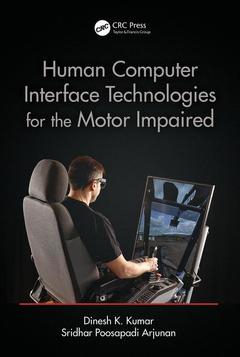Human-Computer Interface Technologies for the Motor Impaired Rehabilitation Science in Practice Series
Auteurs : Kumar Dinesh K., Arjunan Sridhar Poosapadi

Human Computer Interface Technologies for the Motor Impaired examines both the technical and social aspects of human computer interface (HCI). Written by world-class academic experts committed to improving HCI technologies for people with disabilities, this all-inclusive book explores the latest research, and offers insight into the current limitations of this field. It introduces the concept of HCI, identifies and describes the fundamentals associated with a specific technology of HCI, and provides examples for each. It also lists and highlights the different modalities (video, speech, mechanical, myoelectric, electro-oculogram, and brain-waves) that are available, and discusses their relevant applications.
Easily and readily understood by researchers, engineers, clinicians, and the common layperson, the book describes a number of HCI technologies ranging from simple modification of the computer mouse and joystick to a brain?computer interface (BCI) that uses the electrical recording of the brain activity of the user. The text includes photographs or illustrations for each device, as well as references at the end of each chapter for further study.
In addition, this book:
- Describes the mechanical sensors that are used as an interface to control a computer or screen for the aged and disabled
- Discusses the BCI using brain waves recorded by noninvasive electrodes to recognize the command from the user
- Presents the myoelectric interface for controlling devices such as the prosthetic/robotic hand
- Explains the technology of tracking the eye gaze using video
- Provides the fundamentals of voice recognition technologies for computer and machine control applications
- Examines a secure and voiceless method for the recognition of speech-based commands using video of lip movement
Human Computer Interface Technologies for the Motor Impaired
Introduction. Human–computer interface: Mechanical sensors. Brain–computer interface based on thought waves. Evoked potentials-based brain–computer interface. Myoelectric-based hand gesture recognition for human–computer interface applications. Video-based hand movement for human–computer interface. Human–computer interface based on electrooculography. Video-based eye tracking. Speech for controlling computers. Lip movement for human–computer interface.
Dinesh K. Kumar received a B.Tech from IIT Madras, and a Ph.D in biomedical engineering from IIT Delhi and AIIMS, Delhi. He is a professor and leader of biomedical engineering at RMIT University, Melbourne, Australia. Dr. Kumar has published more than 330 refereed papers in the field, and his interests include muscle control, affordable diagnostics, and human–computer interface. He is editor of multiple journals, chairs a range of conferences related to biomedical engineering, and enjoys walking in nature in his spare time.
Sridhar Poosapadi Arjunan received a B.Eng in electronics and communication from the University of Madras, India; a M.Eng in communication systems from Madurai Kamaraj University, India; and a Ph.D in biomedical signal processing from RMIT University, Australia. He is currently a postdoctoral research fellow with Biosignals Lab at RMIT University. Dr. Poosapadi Arjunan is a recipient of the RMIT SECE Research Scholarship, CASS Australian Early Career Researcher Grant, and the Australia-India ECR Fellowship. His major research interests include biomedical signal processing, rehabilitation study, fractal theory, and human–computer interface applications.
Date de parution : 10-2015
15.6x23.4 cm
Thèmes de Human-Computer Interface Technologies for the Motor Impaired :
Mots-clés :
Human–Computer Interface (HCI); Mechanical Sensors; Modified Devices; Brain–Computer Interface (BCI); Thought Waves; Myoelectric-Based Hand Gesture Recognition; Electrooculography (EOG); Video-Based Eye Tracking; Speech-Based Machine Commands; BCI; Automatic Speech Recognition (ASR); Eye Blink; Speech Denoising Methods; BCI System; Phonemes; AVI File; Place Principle Hearing Model; Wavelet Transform; Artificial Neural Networks; SSVEP; Lip Movement Voiceless Speech Recognition Systems; Peripheral Device; Wheelesley; Adaptive Filtering; Robotic Wheelchair System; EPOC; MIT; VEPs; Computer Mouse; SSVEP Response; Joystick; Eye Movements; Trackball; Support Vector Machines; Computer Tablet; Zernike Moments; Eye-Tracking Interface; AVI; Touch Sensitive; Grip Patterns; Pressure Sensitive; Hough Transform; Stylus; EEG Headset; Active Screens; Transradial Amputee; Special Needs; Background Activity; EEG Signal; BCI Device; CHT; Controller Board; Electrooculogram Signals



